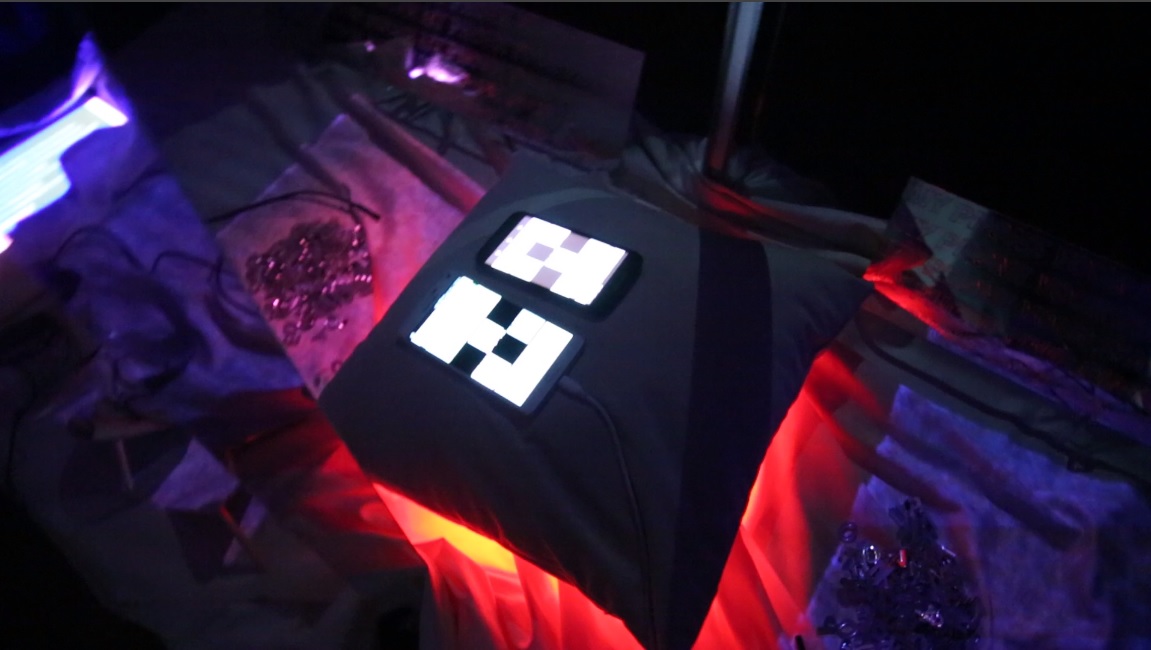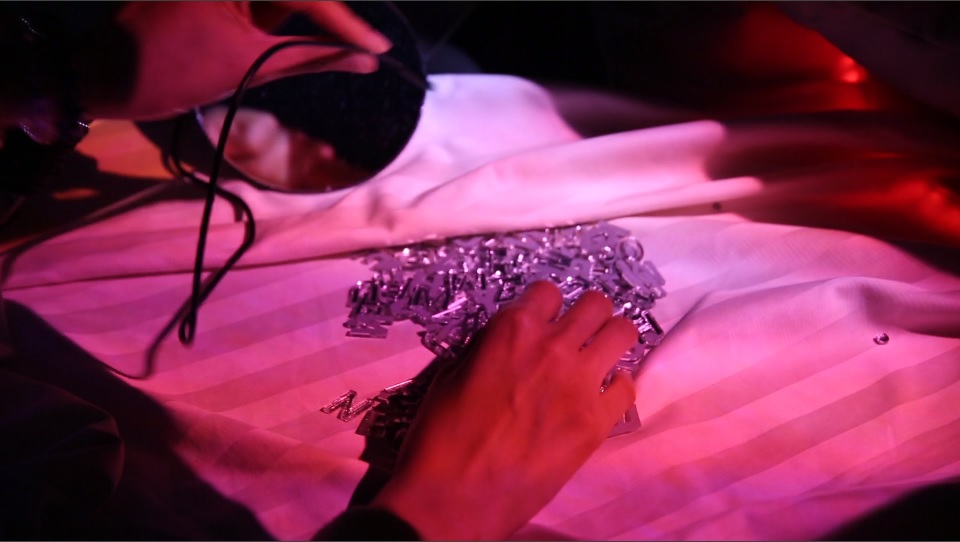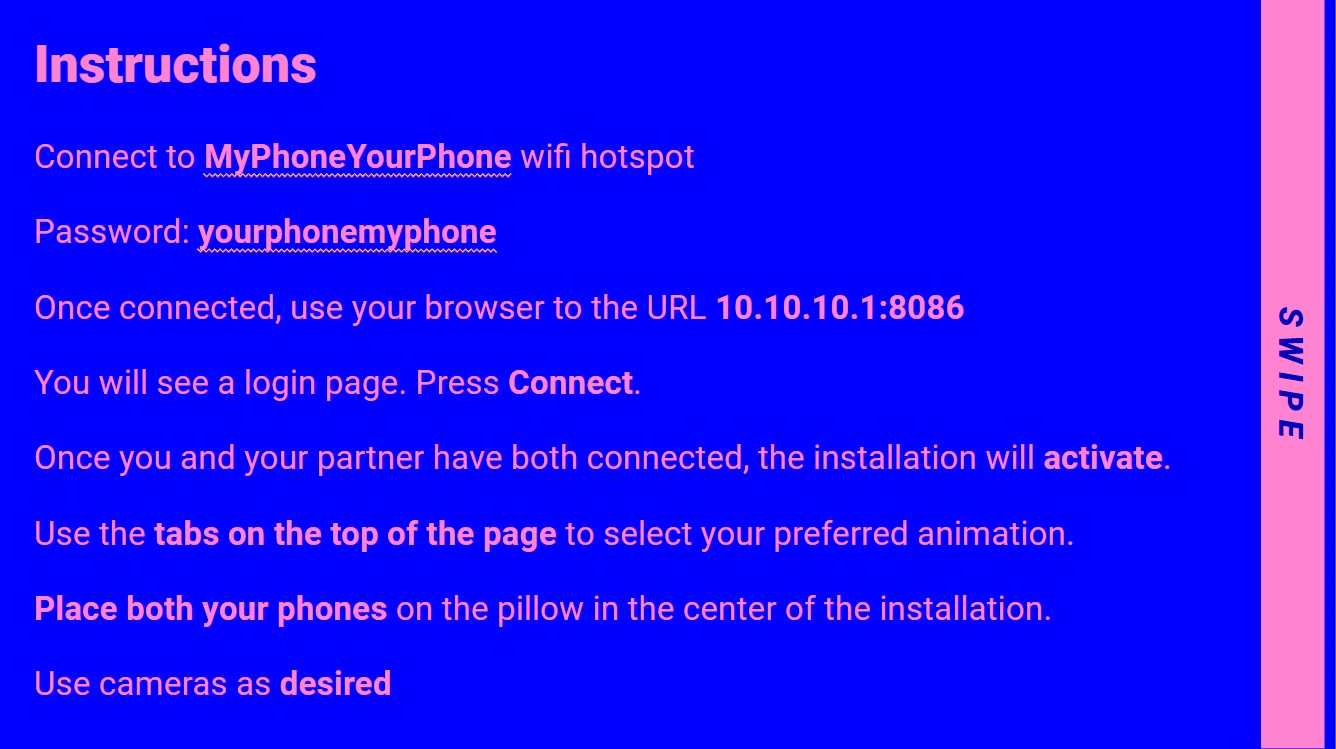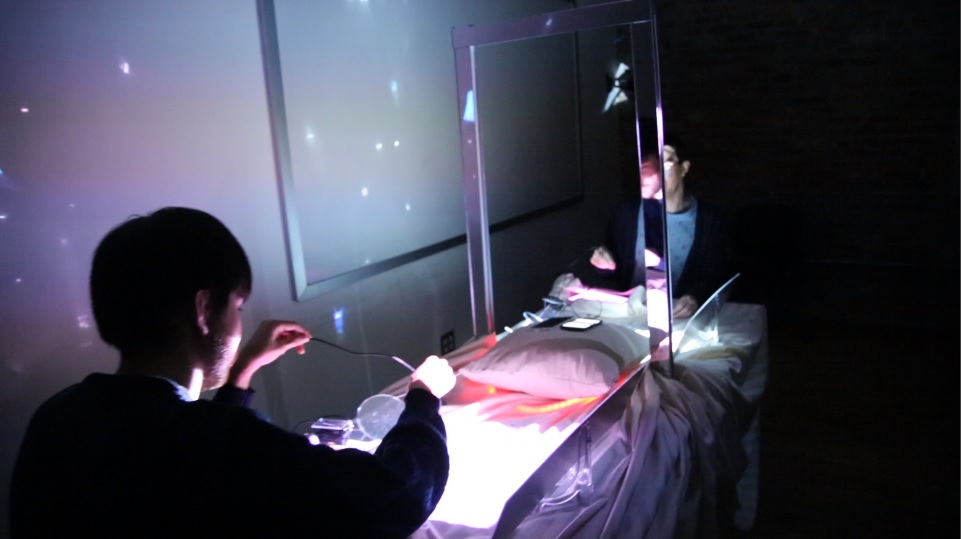Art Installation
MY PHONE YOUR PHONE
“MY PHONE YOUR PHONE” is an interactive installation that requires two users to simultaneously connect to a local web server on their phones and navigate to a web page. This page offers a few variations on simplistic animations that feature the words: My Phone Your Phone Mine Ours. Once two users are detected, the physical installation is activated.
Demo Video



There are two chairs on either side of the installation. At each seat there is a tablet displaying the following instructions:

Instructions screenshot
Once two users are detected, the illuminated color at the center of the installation will begin to shift. Slowly, the table space in front of each seat will be illuminated with a projected video feed. A small wire camera is one of the features on each side of table, and what it sees is being projected onto the table.

The table itself is covered in a bedsheet. I chose a sheet textured in a manner conspicuous as a piece of bedding specifically as opposed to cloth that might be misconstrued as a neutral background. The tablets are cradled in matching pillow covers. The rest of the table includes: a triangle and circle shaped mirror, an iridescent see through acrylic holder around which the wired cameras are wrapped, a pile of mirrored letters that have all the letters from “MY PHONE YOUR PHONE” and their negative spaces, and a two foot long acrylic mirror with the phrase “MY PHONE YOUR PHONE” etched onto the mirror face.

In the middle is a frame, made from mirrored acrylic. It is three feet high, in a “portrait” orientation, and its base is under the sheets, seemingly emerging from them. At the base of this large mirrored frame is a pillow. Under this pillow and under the sheets is the lighting system.
The technical setup involved a machine running Max MSP. This machine is connected to an Arduino that controls a strip of neopixel RGB LED lights. The wire cameras are USB devices, brought into the Max patch and mapped/positioned onto the table surface using the cornerpin object. Mira frame objects are places over the animated images, composed of mutlisliders and text objects. Miraweb allows these animations to be accessed by users of the installation, and also keeps track of how many users are connected. Once two users are detected, the video feeds of the USB cameras are faded in and the lighting of the installation changes. Once less than two users are detected, the feed fades out and then the light returns to its ambient resting state.
This project is the end result of two previous approaches. Initially, I had been considering the concept of your phone as a sexual object. I word this specifically as *your* phone, because I didn’t want to simply say that “phones are sexual objects”. The theme I wanted to stick to throughout each incarnation of this project was that the readymade object is *your* phone. The mass produced object that I wish the audience to consider is the one that they call their own, which will be carried away from the piece itself.
A phone can be literally sexual in multiple ways: sexting, a repository of sexual images of ourselves and our lovers, a way to communicate with lovers, a way to find lovers, a way to consume pornography. But it has general descriptors of a sexual characteristics, as well. An object that is private, an object that you may hesitate to arbitrarily hand to a stranger, the thing in your pants that has your personal flora all over it, a method of connecting you to those you love, a voyeuristic venue, an exhibitionist venue, a kind of addiction, an object of self identity and self pleasure that can involve others to varying degrees.
In play testing different iterations of the build, there were plenty of good lessons learned on technical hurdles and practical approaches to user interaction for artistic ends. Having discussions and critique with the class, I found myself either going far too obvious in sexual metaphor and imagery, or over-correcting with something more subtle and perhaps losing the message. But it was this last concept that stuck with me: an object of self identity and self pleasure that can involve others to varying degrees.
I had considered installations that would hopefully guide two people to use their cellphones to act in concert with each other, but leaving a sort of ambiguity as a space for discussion between the participants as to what they should be doing. This, in my mind perhaps might create a natural consent exercise: two people negotiating and collaborating together for mutual satisfaction, or “making something beautiful together”.
But after being prompted to keep thinking about what the piece is really about, I wondered if my take was perhaps a view of 20th century-era Internet utopianism: the network as inherently collaborative, the intrinsic “togetherness” of networked machines as a deterministic march towards a future that arcs towards a progressive, interdependent future.
However in the 21st century, as a cellphone society we aren’t all uniformly “making something beautiful together” in line with these aspirations. Why should a piece about cellphones indicate otherwise? Though, I’m reticent to throw my viewpoint into full reverse. Transcendentalist redux, 2017 Black Mirror-cyberpunk rehash, and simple pop culture contrarianism lacks a sense of complexity and subtlety I believe the situation requires. Common prescriptions for our cultural cellphone ailments and fantastic predictions from Silicon Valley’s 1990 crystal ball both share a tendency to fix in place what a cellphone is used for, what they do to us and why we want to use them.
Then the meditation that resonated with me is: what a cellphone is for? And what is my cellphone about? And yours?
Is a cellphone used more to view others? Or transmit images of the receiver? In either case, are the underlying reasons selfish or communitarian?
Is a cellphone a selfie machine? A monitoring device? A library card to an electronic library of Alexandria? An escapist distraction?
Is a cellphone a mirror or a frame?
The reductive answer to these questions is that each person is different and uses their cellphone for their own reasons, even if those reasons may be unconsidered. And furthermore, may oscillate for any given user multiple times throughout the day.
In abstracting this concept, I decided to make a physical interpretation of a cell phone. A frame that is also a mirror that sits between you and another person. I have been describing it as a deconstruction of a cell phone that attempts to create a metaphorical play space.
The different elements laid out in front of the participant can be categorized in themes of cell phone usage. Viewing of the self, through mirrors. Viewing of another and their activity, through a frame. A tool to monitor, through a controllable camera. A place to play, using all items to create entertaining images with the camera.

Small, charm-like letters viewed through the camera can be thought of in a context of written text communication shared via screens. But also because they can be freely re-arranged, perhaps a consideration of online re-mix culture. Certain aspects such as this only occurred to me until after I had fabricated certain parts, played with the piece myself, and invited others to do the same.
This is in line with a broader goal that I have with this piece. I don’t want to say explicitly: the small letters are a metaphor for online remix culture, and thus this must be properly communicated to the audience.
I had certain ideas that were fixed, like the central mirror frame and your cellphones in the middle. But my hope was to continually consider a general “cellphone-ness” and imbue all of my artistic decisions with this attitude as a method of creation. If I kept in this mental mode, I hoped to not only create the metaphors I intended, but also have other relevant metaphors emerge. For example, during fabrication I was struck by the realization: how can I talk about cell phones and not have a text element in the piece? Having a pile of laser cut letters around while working on other things, fellow students were happy to play with them. Names, swears, nonsense gibberish and geometric patterns came and went with delight. Remixing as a theme then occurred to me.
And in this spirit, I wanted the end piece to have a playful quality with emergent themes. If people use cell phones in their own way, they should use the piece in their own way as well. To some, there may be more themes of reflection and perhaps narcissism. To others, there may be a simple entertainment of camera manipulation; a crazy, shiny, digital nonsense world for two. I wanted to see if themes could emerge because of a commitment to the metaphor, where the topic of the piece isn’t just the subject but also the way in which the piece should be created.
The only necessary thematic anchor, the phone of the audience, is placed in the center of the piece. My hope was to make it almost altar-like, yet also intimate, two phones resting on a glowing pillow surrounded by soft sheets in the middle of everything. If this can be the literal and metaphorical center of the piece, hopefully all meditations and ruminations on the piece and what is happening can be placed in the phone context.
My blue sky scenario for this piece would be to have someone to understand the cell phone context, engage in meditation on that theme, and share a metaphor had not occurred to me but still resonates completely.